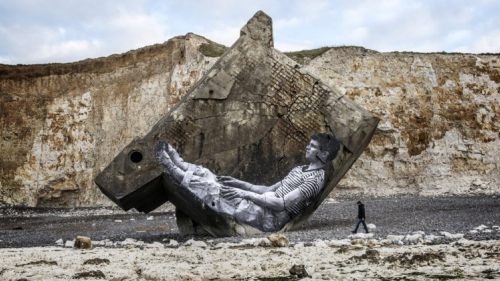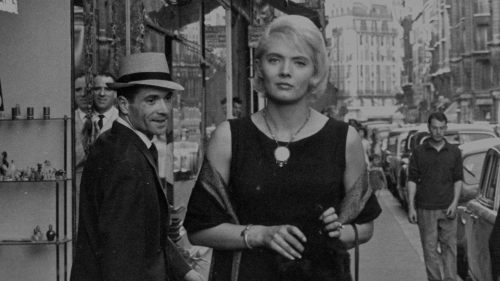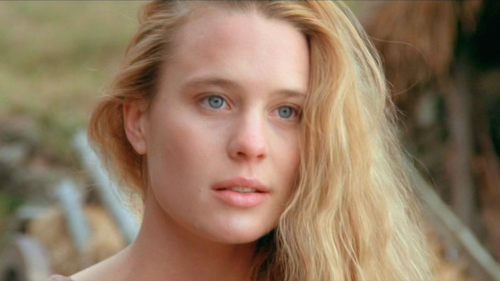Broad Cinema: SUNSET BOULEVARD And QUEEN KELLY, The Story Of Two Masterpieces
From Alice Guy-Blaché to Ava Duvernay, women have been integral to cinema for the last 120 years. Broad Cinema is a new column that will feature women who worked on films that are playing this month at the Alamo Drafthouse. From movie stars to directors, from cinematographers to key grips, Broad Cinema will shine a spotlight on women in every level of motion picture production throughout history.
This week we are celebrating Gloria Swanson in Sunset Boulevard. Get your tickets here!
Sunset Boulevard opens with our writer-narrator, Joe Gillis, lying face down in a pool dead: his past has caught up with him. Billy Wilder’s 1950 masterpiece about the ruthlessness of Hollywood is preoccupied with the past in an industry where you are only as good as your last picture. The aging Norma Desmond, once among the brightest stars in the sky, is trying to recapture her glory days in an industry that bears little resemblance to the one that launched her career. Using real Hollywood history, Wilder draws on the past of his actors to create a rich and macabre portrait of the dream maker’s factory.
In one of the most iconic scenes in the film, Norma Desmond screens scenes from an old film of hers. Projected in a darkened smoke-filled room, her young face is lit by candlelight that seems to have a silvery sheen. Desmond rises out of the darkness declaring dramatically, “ We didn't need dialogue. We had faces!”
The silent scene is a sequence from a film that had never been screened to a general audience in America by 1950, the maligned and butchered Queen Kelly, a 1929 film that starred Gloria Swanson and was directed by her co-star in Sunset Boulevard, Erich von Stroheim. At the time of casting the film, Billy Wilder claims to have not known the pair had worked together so intimately in the past. Nonetheless, this added detail makes Sunset Boulevard not only a horrific indictment on Hollywood but in a way, a form of redemption for Queen Kelly - an unfinished and unseen almost-masterpiece.
In 2017, it is possible to watch what remains of Queen Kelly. Much of the film was never shot and the version that does exist is pasted together with production photos and title cards. Due to the power of the production code at the time, much of the darker elements that von Stroheim had shot were lost to time and censors. He was fired before the film was ever finished with two directors being hired to pick up where he left off, neither lasting more than a month. The movie represented a huge loss for Gloria Swanson personally, who was not just the film’s star but also one of its chief investors. Unwilling to tarnish her already dwindling star power in the 1930s, Swanson pasted together a version that would screen in Europe as she attempted to cushion some of the losses.
What does remain of Queen Kelly is pretty remarkable, in part for its sensual beauty but also for its strange resemblances to Sunset Boulevard. The film is about a teenage girl in a convent who is courted by a prince betrothed to a decadent old Queen. What begins as a fun affair quickly becomes more serious, but as the prince soon finds out, you don’t cross the Queen without disastrous consequences. The film is rich with fetishistic imagery and less-than-subtle erotic tensions that make your skin crawl.
By this time in his career, von Stroheim had long established his reputation as one of the most obsessive and difficult filmmakers in the world, but his films sparkled with beauty and richness: the risk seemed worthwhile. Swanson recollected those early days on the shoot, before things went sour, saying, “[Stroheim] was so painstaking and slow that I would lose all sense of time, hypnotized by the man’s relentless perfectionism” (190). The early rushes were convincing and “breathtaking”, as Swanson explained in her autobiography, “Every scene was alive with glowing light play and palpable texture. You could almost smell the thin Havana cigars and taste the Viennese coffee and feel the dew on the grass.” Stroheim would always answer, “That could be better”.
As optimistic as the production was at this point, things would soon spiral out of control. Stroheim’s pursuit for perfection meant extensive and expensive reshoots. Swanson would recall seeing the same scene that she thought was perfect the first time, from many different angles over the following days. This would only be a part of the problem though, as, without much knowledge from the production team, von Stroheim was shooting extensive sequences that were not in the Production Code approved script.
One such moment was early on in the film, Kelly throws her panties at the Prince in a fit of anger. Swanson was not on set when he shot extensive takes off the Prince pulling them to his face to take a whiff of their smell. These sequences not only extended the shoot but were completely unusable according to the production code. This was only the beginning of a production that was spiraling out of control even before it had really begun.
Billy Wilder had long been an admirer of von Stroheim’s work as a director and as an actor when he first worked with him in Five Graves to Cairo. The disgraced silent film director had a reputation of being as difficult as an actor as he was a director, but somehow, Wilder got along with him. Recalling their later work on Sunset Boulevard, Wilder explained that during the production von Stroheim approached him with an idea to emphasize that his butler character was still in love with Norma Desmond by including an extensive sequence of the butler cleaning and ironing her panties. Wilder had once said of von Stroheim, “this obsession with foot fetishism, underwear fetishism, other sexual perversions which his pictures are filled with was the real Stroheim”.
Wilder was certainly not the same kind macabre fetishist that Erich von Stroheim was and he did not end up including the panties sequence for obvious reasons, but he certainly drew from Stroheim’s dark vision in Sunset Boulevard.
Take, for example, our introduction to Norma Desmond as she mourns the death of her chimp companion and has a funeral for him. Clouded in darkness, this sequence has an edge of the unreal that blurs the line between man and animal. Evident even in what remains of Queen Kelly, the animal within man is a throughline that runs through most of von Stroheim’s work. Somehow, this sequence feels completely at home in the brutalistic aristocracy of one of von Stroheim’s earliest works, Foolish Wives, where he plays a noble counterfeiter who begins each day by drinking a glass full of ox-blood.
For von Stroheim, being perceived as aristocratic was essential - and his agreement to even be a butler was with the understanding that the character had once been “a great man.” This seems to mirror the real world where at the height of the 1920s von Stroheim had been considered one of the world’s greatest filmmakers, with silent film actress Louise Brooks calling him “the one pure visual genius of film” but had been reduced to supporting character actor.
The relationship between Norma Desmond and her butler, who had once been her director and husband, is a supporting beam that helps make Sunset Boulevard far more than the pathetic ambitions of a washed-up actor. It helps suggest a real and even tragic former life beyond the real and tragic present. Even for those unaware of Queen Kelly, when Gloria Swanson’s piercing eyes reflect candlelight as the older Desmond watches - we feel the scope of beauty, ambition, and loss within that very sequence. With von Stroheim lingering in the background, we pass through time, to a moment of crushing and crippling obsession just barely softened by the passing decades.
From the earliest days of Hollywood, directors and writers could not help turning the gaze back on itself. Like a collapsing set of mirrors, reflecting endless visions of fame, ambition, and failure, Hollywood filmmakers could not escape the allure of committing to its own stories. Few films in the history of that prevalent sub-genre approach the level of mastery and metatextuality as Sunset Boulevard, which brings the past alive without any sunny nostalgia. Learning about the tricky past of Queen Kelly, the first reunion between Gloria Swanson and Erich Von Stroheim only enhances that dark history - deepening the appreciation for Wilder’s dark Hollywood masterpiece.
Details from behind the scenes of Queen Kelly were drawn from two books on Gloria Swanson, Gloria Swanson: The Ultimate Star by Stephen Michael Shearer and Gloria Swanson’s autobiography Swanson on Swanson. Further research from Charlotte Chandler’s Book, Nobody's Perfect: Billy Wilder : a Personal Biography.



